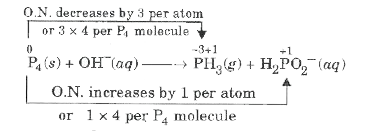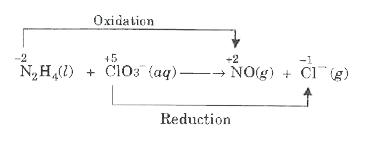Balance the following equations in basic medium by ion-electron method and oxidation number methods and identify the oxidising agent and the reducing agent.
(a) P4(s)+OH−(aq)→PH3(g)+HPO−2(aq)
(b) N2H4(1)+ClO−3(aq)→NO(g)+Cl−(g)
(c) Cl2O7(g)+H2O2(aq)→ClO−2(aq)+O2(g)+H+

P4 gets oxidised to H2PO−2 and reduced to PH3 and therefore , P4 acts as reducing agent as we as oxidising agent .
Oxidation number method

Balance the increase or decrease in oxidation number by multiplying H2PO−2 by 3 and PH3 by 1.
P4(s)+OH−(aq)→PH3(g)+3H2PO−2(aq)
To balance O atoms , multiply OH− by 6,
P4(s)+6OH−(aq)→PH3(g)+3H2PO−2(aq)
To balance H atom , add , 3 H2O to L.H.S and 3OH− on R.H.S , we have
P4(s)+6OH−(aq)+3H2O(l)→PH3)(g)+3H2PO−3(aq)+3OH−(aq)
or P4(s)+3OH−(aq)+3H2O(l)→PH3(g)+3H2PO−2(aq)
Ion electron method
The equation can be split up as
Oxidation half reaction : P4(s)→H2PO−2(aq)
Reduction half reaction : P4(s)→PH3(g)
These can be balanced separately as :
Oxidation half reaction
0P4(s)→H2+1PO−2(aq)
P4(s)→4H2PO−2(aq)
P4(s)→4H2PO−2(aq)+4e−
P4(s)+8OH−(aq)→4H2PO−2(aq)+4e− ...(i)
Reduction half reaction
0P4→−3PH3(g)
P4(s)→4PH3(g)
P4(s)+12e−→4PH3(g)
P4(s)+12e−→4PH3(g)+12OH−(aq)
P4(s)+12H2O(l)+12e−→4PH3(g)+12OH−(aq) ...(ii)
To balance electrons , multiply eq. (i) by 3 and add to eq. (ii)
4P4(s)+12OH−(aq)+12H2O(l)→4PH3(g)+12H2PO−2(aq)
or P4(s)+3OH−(aq)+3H2O(l)→PH3(g)+3H2PO−2(aq)
(b) 
In this reaction , N2H4 gets oxidised and acts as a reducing and ClO−3 gets reduced and acts as an Oxidising agent
Oxidation number method

To balance the increase or decrease in oxidation number , multiply N2H4 by 3 and ClO−3 by 4 and add
3N2H4(l)+4ClO−3(aq)→NO(g)+Cl−(aq)
Balance N and Cl atoms on R.H.S
3N2H4(l)+4ClO−3(aq)→6NO(g)+4Cl−(aq) To balance O atoms add 6H2O molecules on R.H.S .
Since H atoms are balanced automatically , the above equation represents balanced chemical equation.
Ion electron method
Oxidation half reaction : N2H4(l)→NO(g)
Reduction half reaction : ClO−3(aq)→Cl−(aq)
These can be balanced separately as :
Oxidation half reaction :
N2H4(l)→NO(g)
N2H4(l)→2NO(g)
−2N2H4(l)→2+2NO(g)+8e−
(balancing OH− ions)
N2H4(l)+8OH−(aq)→2NO(g)+6H2O(l)+8e− ...(i)
Reduction half reaction
ClO−3(aq)→Cl−(aq)
+5ClO−3+6e−→−1Cl−(aq)
ClO−3(aq)+6e−→Cl−(aq)6OH−(aq)
ClO−3(aq)+3H2O(l)+6e−→Cl−(aq)+6OH−(aq) (ii)
To balance electrons ,multiply eq (i) by 3 and eq (ii) by 4
3N2H4(l)+4ClO−3(aq)→6NO(g)+4Cl−(aq)+6H2O(l)
(c) 
In this reaction , Cl2O7 gets reduced adn acts as an oxidising agent while H2O2 gets oxidised and acts as a reducing agent .
Oxidation number method

To balance the increase or decrease in oxidation number , multiply H2O2 by 4 and add
Cl2O7(g)+4H2O2(aq)→ClO−2(aq)+O2(g)
Balance Cl atoms and O2
Cl2O7(g)+4H2O2(aq)→ClO−2(aq)+4O2(g)
balance Cl multiply 2ClO−2(aq)+4O2(g)
To balance O atoms , add 3H2O molecules on R.H.S
Cl2O7(g)+4H2O2(aq)→2ClO−2(aq)+4O2(g)+3H2O(l)
To balance H atoms , add 2H+ on R.H.S since the medium is acidic
Cl2O7(g)+4H2O2(aq)→2ClO−2(aq)+4O2(g)+3H2O(l)+2H+(aq)
Ion electron method
Oxidation half reaction : H2−1O2(aq)−0O2(g)
Reduction half reaction : Cl2O7(g)→ClO−3(aq)
These can be balanced separately as :
Oxidation half reaction
H2−1O2(aq)−O2(g)
H2−1O2(aq)−O2(g)+2e−
Since the reaction occurs in acidic medium add 2H+ on R.H.S to equate charge ,
Cl2O7(g)→ClO−2(aq)
Cl2O7(g)→2ClO2(aq)
Cl2O7(g)+8e−→2ClO−2(aq)
Cl2O7(g)+8e−+6H+(aq)→2ClO−2(aq)
(medium is acidic)
Cl2O7(g)+6H+(aq)+8e−→2ClO−2(aq)+3H2O ...(iii)
To balance electrons , multiply eq. (i) by 4 and add to eq (ii)
Cl2O7(g)+4H2O2(aq)→2ClO−2(aq)+4O2(g)+3H2O(l)+2H+(aq)
Topper's Solved these Questions
- BOOK - MODERN PUBLICATIONCHAPTER - REDOX REACTIONS EXERCISE - NCERT FILE Solved (NCERT - Exemplar Problems)) (Multiple Choice Questions (Type - I)1videos
REDOX REACTIONS
- BOOK - MODERN PUBLICATIONCHAPTER - REDOX REACTIONS EXERCISE - NCERT FILE Solved (NCERT - Exemplar Problems) (Multiple Choice Questions (Type - I)10videos
REDOX REACTIONS
- BOOK - MODERN PUBLICATIONCHAPTER - REDOX REACTIONS EXERCISE - Conceptual Questions20videos
REDOX REACTIONS
- BOOK - MODERN PUBLICATIONCHAPTER - ORGANIC CHEMISTRY: BASIC PRINCIPLES AND TECHNIQUESEXERCISE - (Competition File) MULTIPLE CHOICE QUESTIONS ( based on the given. passage/comprehension )8videos
ORGANIC CHEMISTRY: BASIC PRINCIPLES AND TECHNIQUES
- BOOK - MODERN PUBLICATIONCHAPTER - S-BLOCK ELEMENTS ( ALKALI AND ALKALINE EARTH METALS ) EXERCISE - UNIT PRACTICE TEST13videos
S-BLOCK ELEMENTS ( ALKALI AND ALKALINE EARTH METALS )
Similar Questions
Balance the following equations in basic medium by ion-electron method and oxidation number methods and identify the oxidising agent and the reducing agent.
(a) P4(s)+OH−(aq)→PH3(g)+HPO−2(aq)
(b) N2H4(1)+ClO−3(aq)→NO(g)+Cl−(g)
(c) Cl2O7(g)+H2O2(aq)→ClO−2(aq)+O2(g)+H+View SolutionBalance the following equations in basic medium by ion-electron method and oxidation number methods and identify the oxidising agent and the reducing agent.
(a) P4(s)+OH−(aq)→PH3(g)+HPO−2(aq)
(b) N2H4(1)+ClO−3(aq)→NO(g)+Cl−(g)
(c) Cl2O7(g)+H2O2(aq)→ClO−2(aq)+O2(g)+H+View Solution
Knowledge Check
- Question 1 - Select One or More
4M(s)+8CN−(aq)+2H2O(aq)+O2(g)→4[M(CN)2](aq)+4OH−(aq).Here
AO2 acts as oxidizing agentBCN− acts as complex forming agent.CO2andCN− both act as oxidizing agents.DO2andCN− both act as complex forming agents. - Question 2 - Select One or More
4M(s)+8CN−(aq)+2H2O(aq)+O2(g)→4[M(CN)2](aq)+4OH−(aq).Here
AO2 acts as oxidizing agentBCN− acts as complex forming agent.CO2andCN− both act as oxidizing agents.DO2andCN− both act as complex forming agents.
(Associativity ) Let f:A→B,g:B→C and h:C→. Then prove that ( h o g) o f = h o ( g o f )
View Solution(Associativity ) Let f:A→B,g:B→C and h:C→. Then prove that ( h o g) o f = h o ( g o f )
View SolutionBalance the equation
As2(s)+NO−3(aq)+H+(aq)→AsO+(4)3−(aq)+S(s)NO(g)+H2O(l)View SolutionBalance the equation
As2(s)+NO−3(aq)+H+(aq)→AsO+(4)3−(aq)+S(s)NO(g)+H2O(l)View SolutionBalance the following reactions by ion electron method : Cl2+OH−→ClO3+Cl+H2O
View SolutionO3(g)+I−(aq)+H2O(l)→
View Solution

